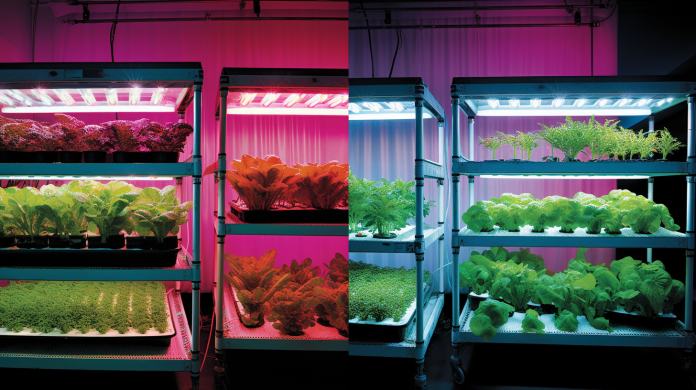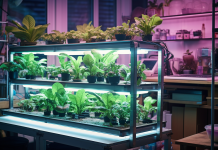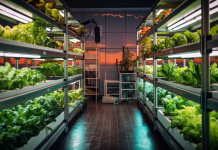In the world of hydroponics, choosing the right lighting system is crucial for maximizing plant growth and productivity. In this article hydroponic lighting options compared we delve into the three main options available: LEDs, HID, and fluorescents.
By examining factors such as energy efficiency, light spectrum, heat output, longevity, and cost, we aim to provide a comprehensive comparison of these hydroponic lighting options.
Whether you are an experienced hydroponic grower or just starting out, this article may help you make an informed decision for your indoor gardening needs.
Understanding LED Hydroponic Lighting
While there are multiple hydroponic lighting options available, it is essential to understand LED hydroponic lighting and its benefits.
LED, which stands for Light Emitting Diode, has gained popularity in recent years due to its energy efficiency and long lifespan. LED hydroponic lights produce a specific light spectrum that is ideal for promoting plant growth and development.
Unlike traditional lighting options such as HID (High-Intensity Discharge) and fluorescents, LED lights consume less energy while providing the same, if not better, light intensity. LED lights also emit less heat, reducing the risk of plant damage and the need for additional cooling systems.
Additionally, LED lights can be customized to emit different wavelengths of light, allowing growers to tailor the lighting to specific plant needs.
Exploring HID Lighting for Hydroponics
Although HID lighting is a traditional option for hydroponics, it still remains a popular choice among indoor gardeners due to its high light output and ability to support vigorous plant growth.
HID, or High-Intensity Discharge, lights are known for their powerful illumination, making them suitable for larger grow spaces. There are two types of HID lights commonly used in hydroponics: Metal Halide (MH) and High-Pressure Sodium (HPS).
MH lights emit a bluish-white light, which is ideal for the vegetative stage of plant growth. On the other hand, HPS lights emit a reddish-orange light, which is well-suited for the flowering stage.
HID lights require a ballast to regulate the electrical current and provide the necessary voltage for operation. While HID lights can generate a significant amount of heat, proper ventilation and cooling systems can help manage the temperature in the grow space effectively.
The Power of Fluorescent Lighting in Hydroponics
Fluorescent lighting offers a versatile and cost-effective option for hydroponic growers looking to provide consistent and efficient lighting for their plants. Here are five reasons why fluorescent lighting is a powerful choice in hydroponics:
- Energy efficiency: Fluorescent lights consume less energy compared to other lighting options, resulting in lower electricity bills.
- Versatility: Fluorescent lights come in different sizes and spectrums, allowing growers to customize the lighting based on the specific needs of their plants.
- Cost-effectiveness: Fluorescent lights are generally more affordable than other options, making them a budget-friendly choice for growers.
- Low heat output: Fluorescent lights produce less heat, reducing the risk of overheating and damage to plants.
- Easy installation: Fluorescent lights are easy to install and can be set up in various configurations to maximize light distribution.
With these advantages, fluorescent lighting proves to be a compelling option for hydroponic growers.
Comparing Energy Efficiency: LEDs Vs. HID Vs. Fluorescents
LEDs, HID, and fluorescent lights differ significantly in terms of energy efficiency, with one option standing out as the most cost-effective and environmentally friendly choice for hydroponic growers.
When it comes to energy efficiency, LEDs are the clear winners. LEDs use significantly less energy compared to HID and fluorescent lights, making them more cost-effective in the long run.
HID lights, such as metal halide and high-pressure sodium lamps, are notorious for their high energy consumption.
Fluorescent lights, on the other hand, are more energy-efficient than HID lights but still fall short compared to LEDs.
LEDs not only save energy but also have a longer lifespan, minimizing the need for frequent replacements. This not only reduces maintenance costs but also reduces the environmental impact associated with manufacturing and disposing of lamps.
Examining Light Spectrum and Plant Growth: LEDs, HID, and Fluorescents
Furthermore, when examining light spectrum and plant growth, it is important to consider the differences between LEDs, HID, and fluorescent lights. Each type of lighting technology emits a different spectrum of light, which can have varying effects on plant growth and development. Here are five key points to consider:
- LEDs: These lights offer a customizable spectrum, allowing growers to tailor the light to the specific needs of their plants. They can provide a full spectrum of light, including both red and blue wavelengths, which are essential for photosynthesis and overall plant health.
- HID Lights: High-intensity discharge lights, such as metal halide (MH) and high-pressure sodium (HPS) lamps, emit a broad spectrum of light that is suitable for all stages of plant growth. However, they may lack certain wavelengths that are important for specific plant needs.
- Fluorescent Lights: While fluorescent lights offer a wide range of spectrum options, they generally lack the intensity required for optimal plant growth. They are more suitable for low-light plants or as supplemental lighting.
- UV and Far-Red Light: Some LEDs can provide UV and far-red light, which can have specific effects on plant growth, such as enhanced resin production or flowering.
- Light Intensity and Duration: The intensity and duration of light exposure also play a crucial role in plant growth. Different lighting technologies may require adjustments in intensity and duration to achieve optimal results.
Considering these factors can help growers choose the most suitable lighting technology for their specific plant requirements, maximizing growth and overall yield.
Heat Output and Cooling Considerations: LEDs, HID, and Fluorescents
When considering heat output and cooling considerations, growers must take into account the differences between these lighting technologies.
LED grow lights are known for their low heat output, making them ideal for indoor gardening. They produce very little heat compared to HID (High-Intensity Discharge) and fluorescent lights. This lower heat output allows growers to place the lights closer to the plants without risking heat damage. It also reduces the need for additional cooling equipment, saving energy and costs.
On the other hand, HID lights, such as metal halide and high-pressure sodium, produce a significant amount of heat. This heat output requires proper ventilation and cooling systems to prevent overheating and potential crop damage.
Fluorescent lights fall in the middle, generating less heat than HID lights but more than LEDs.
Growers should carefully consider their specific needs and the heat output of each lighting technology when making their choice.
Longevity and Lifespan: LEDs Vs. HID Vs. Fluorescents
Additionally, growers should consider the longevity and lifespan of LEDs, HID, and fluorescent lights when deciding on the best lighting option for their hydroponic setup. Each type of lighting system has different lifespan characteristics that can impact overall cost and maintenance requirements.
Here are five key factors to consider:
- LEDs have the longest lifespan among the three options, with an average life expectancy of 50,000 to 100,000 hours. This translates to several years of continuous use before replacement is needed.
- HID lights have a shorter lifespan, typically ranging from 10,000 to 20,000 hours. This means more frequent bulb replacements and potentially higher long-term costs.
- Fluorescent lights fall in between LEDs and HID lights, with an average lifespan of around 10,000 to 15,000 hours. They offer a balance between cost and longevity.
- The lifespan of all lighting options can be affected by factors such as operating conditions, maintenance, and the quality of the light fixtures.
- Investing in high-quality lighting systems and proper maintenance can help maximize the lifespan of any lighting option, reducing the need for frequent replacements and minimizing overall costs.
Cost Analysis: LEDs, HID, and Fluorescents in Hydroponic Lighting
A thorough cost analysis of LEDs, HID, and fluorescents is essential for hydroponic growers to make an informed decision about the most economically viable lighting option for their setup. While LEDs may have a higher upfront cost compared to HID and fluorescents, they offer significant long-term savings in terms of energy efficiency and lifespan. HID lights have a lower initial cost but can be expensive to operate due to their high energy consumption. Fluorescent lights are the most affordable option upfront but have shorter lifespans and higher energy usage. To provide a clear comparison, the following table breaks down the cost considerations for each lighting option:
| Lighting Option | Upfront Cost | Energy Consumption | Lifespan |
|---|---|---|---|
| LEDs | High | Low | Long |
| HID | Moderate | High | Moderate |
| Fluorescents | Low | Moderate | Short |
Key Takeaways
- LED lights are the most energy efficient option.
- HID lights have high energy consumption and produce a significant amount of heat.
- Fluorescent lights are more energy efficient than HID lights but less efficient than LEDs.
- LEDs have the longest lifespan and offer long-term savings in energy efficiency and lifespan.
Conclusion
In conclusion, hydroponic lighting options compared may help you consider factors such as energy efficiency, light spectrum, heat output, longevity, and cost. LED lighting offers high energy efficiency and a customizable light spectrum, while HID lighting provides intense light output.
Fluorescent lighting is cost-effective and suitable for smaller-scale operations. Ultimately, the choice of lighting depends on the specific needs and goals of the hydroponic system.
Please see our supporting article:
Advanced Lighting Techniques for Optimizing Hydroponic Growth



